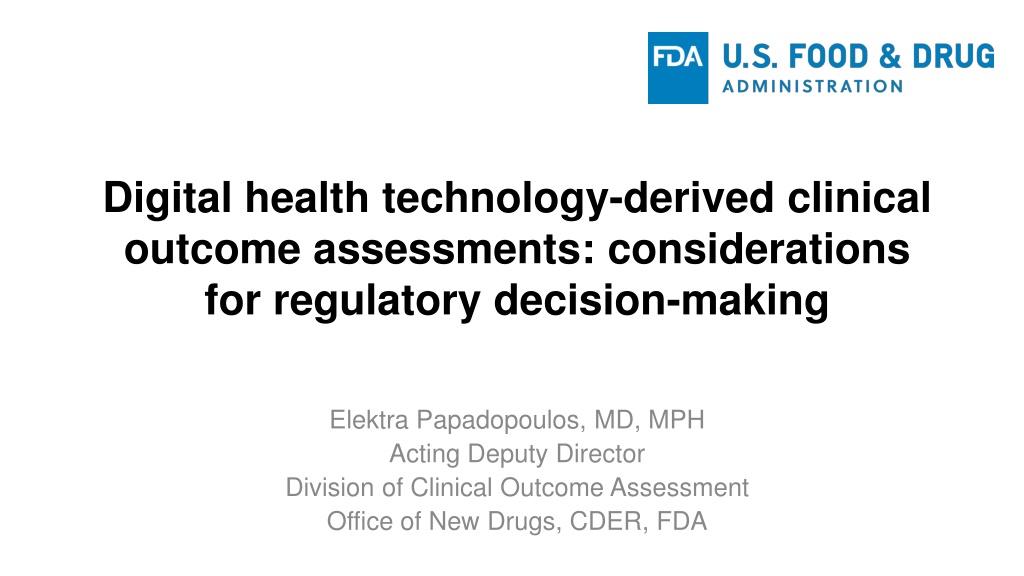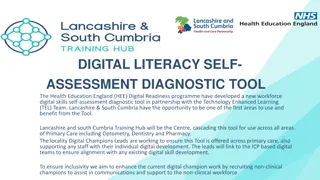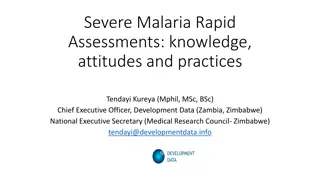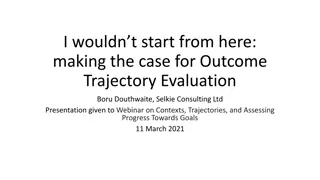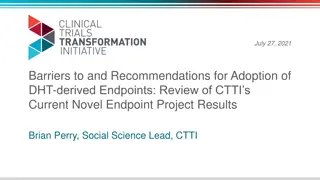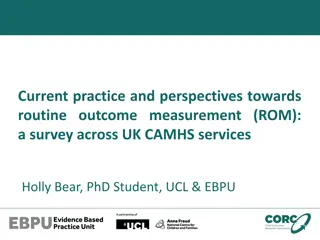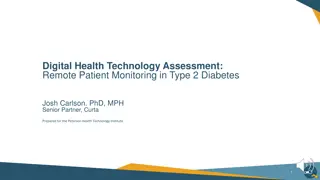Understanding Digital Health Technology-Derived Clinical Outcome Assessments
This presentation delves into digital health technology-derived clinical outcome assessments (COAs) and their significance in regulatory decision-making. Exploring the definition of digital health technology (DHT), the focus on digitally collected COAs, examples from consortium workshops, and potential benefits of DHT-derived COAs, it emphasizes the importance of fit-for-purpose endpoints in ensuring valid and reliable measurement of clinically relevant concepts.
Download Presentation

Please find below an Image/Link to download the presentation.
The content on the website is provided AS IS for your information and personal use only. It may not be sold, licensed, or shared on other websites without obtaining consent from the author. Download presentation by click this link. If you encounter any issues during the download, it is possible that the publisher has removed the file from their server.
E N D
Presentation Transcript
Digital health technology-derived clinical outcome assessments: considerations for regulatory decision-making Elektra Papadopoulos, MD, MPH Acting Deputy Director Division of Clinical Outcome Assessment Office of New Drugs, CDER, FDA
Disclaimer Views expressed in this presentation are those of the speaker and do not necessarily represent an official FDA position. 2
What is a digital health technology (DHT)? A system that uses computing platforms, connectivity, software, and/or sensors for healthcare and related uses. These technologies span a wide range of uses, from applications in general wellness to applications as a medical device. They include technologies intended for use as a medical product, in a medical product, or as an adjunct to other medical products (devices, drugs, and biologics). They may also be used to develop or study medical products. SOURCE: BEST (Biomarkers, EndpointS and Other Tools): https://www.ncbi.nlm.nih.gov/books/NBK326791/ 3
We are focusing on digitally collected clinical outcome assessments (COAs): Clinical outcome: An outcome that describes or reflects how an individual feels, functions or survives. Measured using COAs. Digital health technologies can be used in assessments of: Biomarker: A defined characteristic that is measured as an indicator of normal biological processes, pathogenic processes, or biological responses to an exposure or intervention, including therapeutic interventions. SOURCE: BEST (Biomarkers, EndpointS and Other Tools): https://www.ncbi.nlm.nih.gov/books/NBK326791/
An example from PRO Consortiums Chronic Heart Failure Working Group 5 12th Annual PRO Consortium Workshop (April 14-15, 2021)
Potential benefits of digital health technology-derived COAs By enabling remote data capture Endpoints that matter to patients in daily life (e.g., patients experiences between clinic visits) Reduced participation burden/fewer barriers to clinical trial participation (e.g., travel) More inclusive and generalizable trials 6
What does it mean for a DHT-derived COA endpoint to be fit-for-purpose*? Overall considerations same as with any COA: Appropriate for its intended use e.g., Study design Patient population Validly and reliably measure a concept that is Clinically relevant Important to patients Able to show change within the clinical trial Can be communicated in labeling in a way that is accurate, interpretable, and not misleading (i.e., well-defined), if appropriately applied *Fit-for-purpose: A conclusion that the level of validation of a biomarker or COA is sufficient to support its proposed use. 7
Roadmap to patient-focused outcome measurement still applies 8
Were still in the early stages Limited experience in aggregating and summarizing continuously collected DHT data into a clinically meaningful endpoint Methodological issues include (but are not limited to): Defining activity parameters Determining appropriate assessment periods in a day Assessing minimal wear time requirements during a day Collecting and aggregating potentially large volumes of data to derive a score Defining the endpoint Interpreting the data, including meaningful within-patient change Handling missing data 9
In closing, Think with the end in mind: What is the overall COA measurement strategy? What role does the DHT-derived endpoint play and how will it complement other measures/endpoints? What parameters are most meaningful to assess? How will the DHT derived endpoint be defined? How will the benefit be described to stakeholders? Leverage recommendations and resources available Engage with FDA early and often 10
Helpful resources Patient-Focused Drug Development Guidance Series: https://www.fda.gov/drugs/development-approval-process-drugs/fda-patient-focused-drug- development-guidance-series-enhancing-incorporation-patients-voice-medical Drug Development Tool Qualification process guidance: https://www.fda.gov/regulatory-information/search-fda-guidance-documents/qualification- process-drug-development-tools-guidance-industry-and-fda-staff FDA COA Qualification Program Website: https://www.fda.gov/drugs/drug-development-tool-ddt-qualification-programs/clinical- outcome-assessment-coa-qualification-program Critical Path Institute s Patient-Reported Outcome Consortium Annual Workshop https://c-path.org/12th-annual-patient-reported-outcome-consortium-workshop/ FDA guidance on regulatory requirements for record keeping, maintenance, and access (21 CFR Part 11) https://www.fda.gov/media/75414/download 11
